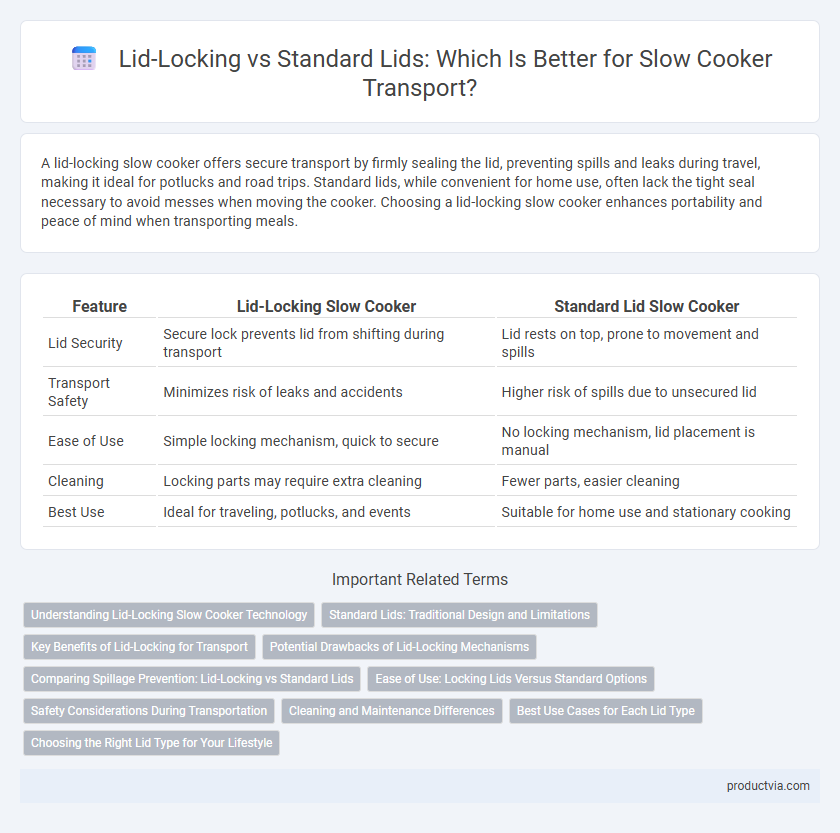A lid-locking slow cooker offers secure transport by firmly sealing the lid, preventing spills and leaks during travel, making it ideal for potlucks and road trips. Standard lids, while convenient for home use, often lack the tight seal necessary to avoid messes when moving the cooker. Choosing a lid-locking slow cooker enhances portability and peace of mind when transporting meals.
Table of Comparison
| Feature | Lid-Locking Slow Cooker | Standard Lid Slow Cooker |
|---|---|---|
| Lid Security | Secure lock prevents lid from shifting during transport | Lid rests on top, prone to movement and spills |
| Transport Safety | Minimizes risk of leaks and accidents | Higher risk of spills due to unsecured lid |
| Ease of Use | Simple locking mechanism, quick to secure | No locking mechanism, lid placement is manual |
| Cleaning | Locking parts may require extra cleaning | Fewer parts, easier cleaning |
| Best Use | Ideal for traveling, potlucks, and events | Suitable for home use and stationary cooking |
Understanding Lid-Locking Slow Cooker Technology
Lid-locking slow cookers incorporate specialized locking mechanisms that secure the lid tightly, preventing spills during transport. This technology features silicone seals and reinforced locks that maintain a secure closure even when the cooker is jostled or tilted. Standard lids lack these locking components, making them less reliable for carrying soups or stews without leakage.
Standard Lids: Traditional Design and Limitations
Standard lids for slow cookers feature a traditional design that rests on the pot without a locking mechanism, making them less secure during transport. This design increases the risk of spills and leaks, especially when moving the slow cooker over uneven surfaces or in vehicles. Users must handle with extra care to prevent accidents, as the lid can easily shift or come off.
Key Benefits of Lid-Locking for Transport
Lid-locking mechanisms on slow cookers provide secure closure, preventing spills and leaks during transport, making them ideal for potlucks and travel. This feature enhances safety by keeping hot contents contained, reducing the risk of burns or messes. Compared to standard lids, lid-locking slow cookers offer increased stability and peace of mind when moving meals from kitchen to destination.
Potential Drawbacks of Lid-Locking Mechanisms
Lid-locking mechanisms on slow cookers provide secure transport but can add complexity and increase the risk of mechanical failure over time. These locks may also complicate cleaning and create tight seals that trap steam, potentially leading to pressure buildup. Standard lids, while less secure during transport, offer simplicity and easier maintenance without the risk of malfunctioning locking components.
Comparing Spillage Prevention: Lid-Locking vs Standard Lids
Lid-locking slow cooker lids provide a secure seal that minimizes spillage during transport, making them ideal for potlucks and travel. Standard lids, which typically rest on top without locking mechanisms, are more prone to shifting and causing spills when the cooker is moved. Choosing a lid-locking slow cooker enhances spillage prevention by maintaining a tight closure, especially on uneven surfaces or during jostling.
Ease of Use: Locking Lids Versus Standard Options
Lid-locking slow cookers provide enhanced ease of use during transport by securely fastening the lid to prevent spills and messes, making them ideal for potlucks and travel. Standard slow cooker lids typically rely on a simple glass cover without locking mechanisms, which can shift or slide off if jostled. The locking lid feature offers peace of mind and convenience, especially when moving hot or liquid-filled dishes.
Safety Considerations During Transportation
Lid-locking slow cookers provide enhanced safety during transportation by securely fastening the lid, minimizing the risk of spills and burns. Standard lids without locking mechanisms may shift or come off easily, increasing the chance of hot contents spilling and causing injuries. Using a lid-locking slow cooker ensures safer handling when moving meals, especially in vehicles or crowded environments.
Cleaning and Maintenance Differences
Lid-locking slow cookers provide a secure seal that significantly reduces spills during transport but often feature more intricate locking mechanisms that require careful disassembly for thorough cleaning. Standard lids are typically simpler, making them easier to clean and maintain, but they lack the secure locking feature that prevents leakage. Choosing between the two depends on prioritizing spill prevention during transport or ease of cleaning and routine maintenance.
Best Use Cases for Each Lid Type
Lid-locking slow cookers provide enhanced security during transportation, making them ideal for potlucks, picnics, and traveling long distances, as the lid stays firmly in place and prevents spills. Standard lids are more suitable for home use or short-distance transport where ease of access and straightforward lid removal are prioritized over spill-proof features. Choosing between lid types depends on whether the primary need is secure transport or convenient cooking and serving at home.
Choosing the Right Lid Type for Your Lifestyle
Lid-locking slow cookers ensure secure closure, preventing spills during transport, ideal for families or potluck gatherings where mobility is frequent. Standard lids, while adequate for home use, lack the locking mechanism, making them less suitable for travel but easier to clean and store. Selecting the right lid depends on your lifestyle needs--opt for lid-locking models for active, on-the-go meal sharing and standard lids for stationary, everyday cooking.
Lid-Locking vs Standard Lid for Slow Cooker Transport Infographic

 productvia.com
productvia.com